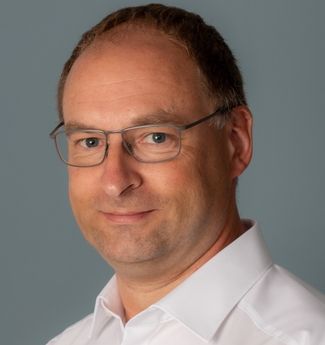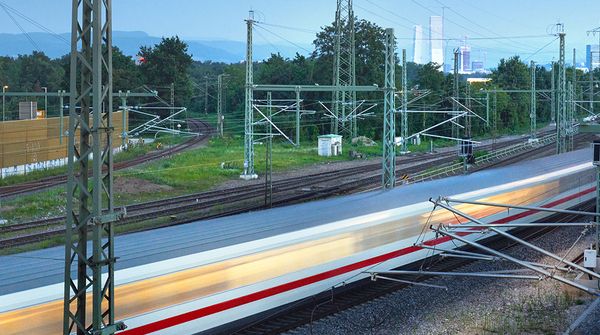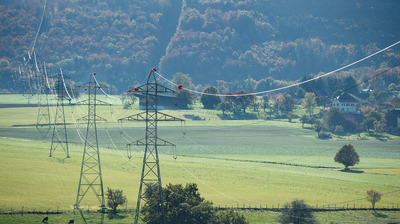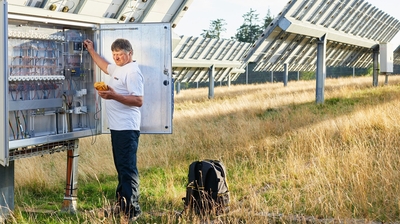At just over five kilometres long, the 132-kilovolt overhead line that supplies power to the SBB and Deutsche Bahn lines in the Basel area and southern Germany is comparatively short – and includes only 25 transmission masts. Nevertheless, replacing the traction power line from the 1950s poses a number of challenges: the line runs through an area in which infrastructure facilities, commercial buildings and residential buildings are packed closely together. “Each individual mast location has its own circumstances that need to be taken into account for planning and subsequent construction,” says experienced line planner Michael Grübnau of LTB Leitungsbau GmbH, part of the BKW network.
«But this line runs partly through the station area and in some sections parallel between an ICE line and a motorway, which it crosses in problematic places.»
Traction power lines usually run directly from the power plant across mostly rural areas to the railway line, he says. “But this line runs partly through the station area and in some sections parallel between an ICE line and a motorway, which it crosses in problematic places.” Existing fibre optic and gas lines in the area of the mast foundations also pose a problem for the line planners.
Gaining experience with BIM for the planning and construction of transmission lines
The complexity of the task makes this traction power line the perfect pilot project: the first transmission line project in Germany to be implemented using the BIM method will serve as a test case for the added value that the digital planning and construction of transmission lines can bring. DB Energie, a subsidiary of Deutsche Bahn, aims to gain relevant experience together with BKW. In doing so, it is following the recommendation of the Federal Ministry for Economic Affairs and Energy to apply the BIM method in public construction projects from 2020 onwards.

BKW expert sees significant added value in this approach
“The BIM method allows us to take advantage of digitalisation in this challenging project,” says Alexandra Krämer, BIM expert at BKW Energy Solutions Ltd. based near Darmstadt (DE). “We capture the facts on the ground – i.e. the existing infrastructure along with the line to be planned and the masts – in a digital twin. The result is a multidimensional data model that maps both the transmission line and the terrain, rails, roads and buildings – as well as deadlines and costs.” For example, the model can simulate different variants for the construction of the masts in order to take account of optimal access routes or work areas at an early stage.
If a change in plans could lead to a conflict with existing infrastructure, the BIM model detects this risk in good time. “Previously, 2D plans were exchanged on paper or digitally. In the process, things could be overlooked or lost when viewed with very different types of software,” explains Krämer. Those are the typical interface problems that arise when each planning expert concentrates only on their own area of expertise, she says. “Combining the specialist models in a coordination model creates a shared, uniform data basis with defined interfaces and responsibilities,” continues Krämer. The challenge now is to obtain 3D models of all the neighbouring buildings that are adjacent to the line. Compared to individual buildings, she says, line infrastructures are much more effort-intensive to model, which is why only a few infrastructure projects, such as motorways and power lines, have been conducted in BIM so far. “With this pilot project, we also want to identify such problems and find solutions to them.”
Time and cost planning are also captured
In order to ensure reliability of supply through the traction power line, all work steps must be precisely scheduled. “The BIM method also helps with this,” says Alexandra Krämer. The coordination model allows time windows to be optimally planned with all project participants. In addition to the planning, the BIM model is also expected to optimise the construction and subsequent operation of the power line. One example of this is storing planned components in the digital twin with information from its construction and operation. The maintenance technician later receives important information about the condition of the components with a single click. This offers a more informed basis for investment decisions and increases the value of the system over the long term.

Swiss and German companies in the BKW network complement each other
The DB Netze power line crosses Swiss territory as well – so BKW Group companies from both countries are working together on this prestige project. In this interview, Kurt Kriesi, head of line construction at BKW Grid & Hydro Engineering, explains how they benefit from each other within the BKW network.
Kurt Kriesi, BKW is planning the first transmission line in Germany to use the BIM method. Why is this the right company for this cross-border prestige project?
Kurt Kriesi: With LTB Leitungsbau GmbH, BKW has an established player in its network that has a wealth of experience in the planning and construction of transmission lines throughout Germany, but it has never planned a line using the BIM method. And this is where we at BKW Grid & Hydro Engineering come in, as we have a broad range of practical BIM experience and have already used BIM in several projects – and not only in transmission line construction. For example, we planned the first switching post in Switzerland in Romanel for the SBB entirely in BIM, and in a transmission line project on Lake Wohlen for BKW itself.
What concrete experience with the BIM method can the Swiss team pass on to the German team?
We’ve shared our entire BIM planning for the two aforementioned projects with LTB and have shown the German team how we proceeded and where we encountered difficulties. We also share our specifications and explain the processes and interfaces we used to get from point A to point B. We’ve been able to give them a bit of orientation based on our concrete project experience, so they don’t have to start from scratch and can always ask questions.
How do you benefit from each other?
One way was with LTB’s useful archive, where we gained access to the plans for the existing masts and their foundations from their construction in 1954 to 1956. These documents make it possible to assess the structural characteristics of the masts with regard to current requirements. We also benefit from the experience LTB has already gained with Deutsche Bahn regarding DB standards and DB regulations, which we were previously unaware of. LTB also uses a completely different BIM tool landscape than we do for the planning of the German part of the traction power line. DB Energie explicitly wants to test two different BIM approaches in this project. Ultimately, we and the customer will have learned the advantages and disadvantages of each tool landscape from this, and where it might be possible to combine some aspects of both. There are many tools with constant data exchange taking place and we can see how fast or complicated it is to reach the goal with the different tools.

Our contribution to sustainability
 | With our actions, products and services, we are contributing to the sustainable development of society, the economy and the environment. BKW develops solutions for the design of sustainable infrastructures and living spaces. In doing so, it is committed to the UN’s Sustainable Development Goals. You can find out more about our approach to sustainability management here. |









Comments
BKW is open to respectful online dialogue (our netiquette) and welcomes your comments and questions. For questions that do not fit the topic above, please use the contact form.